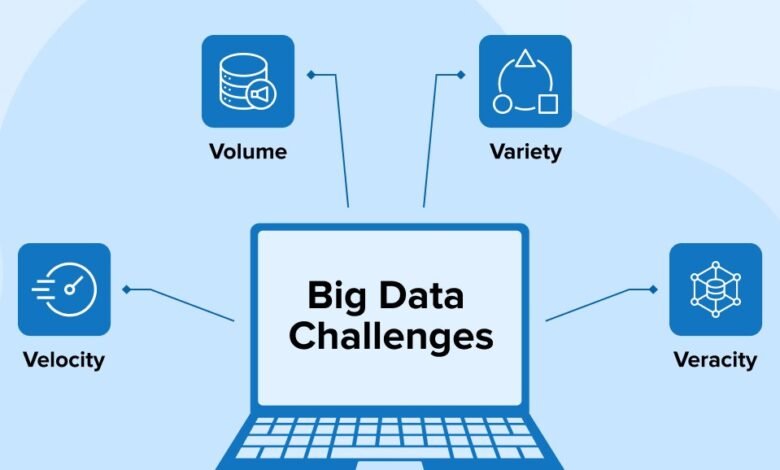Big Data Challenges

Big data has revolutionized how organizations across various industries operate, providing unprecedented insights and driving innovation. However, with the immense volume, velocity, and variety of data comes a set of significant challenges. Addressing these challenges is crucial for harnessing the full potential of big data.
Data Volume
The sheer volume of data being generated every second is staggering. From social media interactions to sensor data from IoT devices, the amount of data produced is growing exponentially. This creates several issues:
- Storage: Traditional storage solutions are often inadequate for handling such vast amounts of data. Organizations need to invest in scalable storage solutions, which can be costly.
- Management: Managing large datasets requires robust systems and processes. This includes ensuring data integrity, consistency, and accessibility across the organization.
Data Velocity
The speed at which data is generated and needs to be processed is another major challenge. Real-time data processing is essential for applications such as fraud detection, real-time analytics, and dynamic pricing. The challenges include:
- Data Ingestion: Rapid data ingestion requires systems capable of handling high-throughput data streams. This involves using technologies like Apache Kafka and Apache Flink.
- Real-time Processing: Real-time analytics demands low-latency processing engines. Solutions such as Apache Storm and Spark Streaming are often employed, but they require significant expertise to implement and maintain.
Data Variety
Big data comes in various formats, including structured, semi-structured, and unstructured data. This variety poses challenges in data integration and analysis:
- Data Integration: Combining data from different sources and formats into a cohesive dataset is complex. ETL (Extract, Transform, Load) processes need to be sophisticated enough to handle diverse data types.
- Data Quality: Ensuring data quality is paramount. Inconsistent or incomplete data can lead to incorrect insights. Data cleaning and preprocessing are essential steps but can be time-consuming and require specialized tools.
Data Veracity
The accuracy and trustworthiness of data are critical. Poor data quality can significantly impact decision-making processes:
- Data Accuracy: Ensuring that data is accurate and reliable involves implementing rigorous validation and verification processes. This can be particularly challenging with data coming from multiple, disparate sources.
- Data Provenance: Tracking the origin and changes to data (data lineage) helps in understanding its reliability and context. Implementing robust data lineage mechanisms is essential but can be complex and resource-intensive.
Data Privacy and Security
With the increasing amount of data comes heightened concerns about privacy and security. Protecting sensitive information is a top priority for organizations:
- Data Protection: Implementing strong encryption and access control mechanisms is vital. This includes ensuring compliance with regulations like GDPR and CCPA.
- Security Threats: Big data systems are attractive targets for cyberattacks. Regular security audits, intrusion detection systems, and employing best practices in cybersecurity are necessary to mitigate risks.
Scalability
As data grows, systems must scale accordingly to handle the increased load. This scalability challenge involves:
- Horizontal Scaling: Adding more servers to distribute the load can be an effective solution. However, ensuring that the system scales efficiently requires careful architecture and design.
- Cloud Solutions: Cloud platforms offer scalable resources on demand. Leveraging cloud infrastructure can help address scalability issues but also requires expertise in cloud management and optimization.
Data Governance
Proper data governance ensures that data is managed and used appropriately across the organization. Challenges in data governance include:
- Policies and Procedures: Establishing clear policies and procedures for data management is crucial. This involves defining roles, responsibilities, and workflows.
- Compliance: Ensuring compliance with industry standards and regulations is essential. This includes regular audits and maintaining detailed records of data handling practices.
Data Integration and Interoperability
Integrating data from various sources and ensuring interoperability between systems can be complex:
- Heterogeneous Data Sources: Data often comes from different systems with varying formats and protocols. Developing mechanisms to seamlessly integrate these sources is challenging.
- Interoperability Standards: Adopting industry standards for data formats and communication protocols can help, but aligning different systems to these standards requires effort and coordination.
Talent Gap
There is a significant demand for skilled professionals who can manage and analyze big data:
- Specialized Skills: Expertise in big data technologies such as Hadoop, Spark, and machine learning is essential. However, finding and retaining such talent can be difficult and expensive.
- Training and Development: Organizations need to invest in continuous training and development programs to keep their workforce up-to-date with the latest advancements in big data technologies.
Cost
Managing big data involves significant costs, including:
- Infrastructure: Investing in high-performance storage, processing capabilities, and network infrastructure can be expensive.
- Software: Licensing fees for big data tools and platforms add to the costs. Open-source solutions can help mitigate some of these expenses but may require more in-house expertise.
Conclusion
While big data offers immense opportunities, it also presents a set of formidable challenges. Addressing these challenges requires a strategic approach, investment in the right technologies, and continuous development of skills and processes. By effectively managing data volume, velocity, variety, veracity, privacy, security, scalability, governance, integration, and talent, organizations can unlock the full potential of big data and drive innovation and growth.




